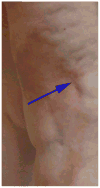The role of skin trauma in the distribution of morphea lesions: a cross-sectional survey of the Morphea in Adults and Children cohort IV
- PMID: 24880663
- PMCID: PMC4135004
- DOI: 10.1016/j.jaad.2014.04.009
The role of skin trauma in the distribution of morphea lesions: a cross-sectional survey of the Morphea in Adults and Children cohort IV
Abstract
Background: Skin trauma may play a role in the development of morphea lesions. The association between trauma and the distribution of cutaneous lesions has never been examined to our knowledge.
Objective: We sought to determine whether patients enrolled in the Morphea in Adults and Children (MAC) cohort exhibit skin lesions distributed in areas of prior (isotopic) or ongoing (isomorphic) trauma.
Methods: This was a cross-sectional analysis of the MAC cohort.
Results: Of 329 patients in the MAC cohort, 52 (16%) had trauma-associated lesions at the onset of disease. Patients with lesions in an isotopic distribution had greater clinical severity as measured by a clinical outcome measure (mean modified Rodnan Skin Score of 13.8 vs 5.3, P = .004, 95% confidence interval 3.08-13.92) and impact on life quality (mean Dermatology Life Quality Index score 8.4 vs 4.1, P = .009, 95% confidence interval 1.18-7.50) than those with an isomorphic distribution. Most frequent associated traumas were chronic friction (isomorphic) and surgery/isotopic.
Limitations: Recall bias for patient-reported events is a limitation.
Conclusion: Of patients in the MAC cohort, 16% developed initial morphea lesions at sites of skin trauma. If these findings can be confirmed in additional series, they suggest that elective procedures and excessive skin trauma or friction might be avoided in these patients.
Keywords: Dermatology Life Quality Index; Morphea in Adults and Children cohort; localized scleroderma; modified Rodnan Skin Score; morphea; skin trauma.
Copyright © 2014 American Academy of Dermatology, Inc. Published by Mosby, Inc. All rights reserved.
Conflict of interest statement
Figures



Comment in
-
The role of skin trauma (isotopic and isomorphic) in the distribution of morphea.J Am Acad Dermatol. 2015 Mar;72(3):560-1. doi: 10.1016/j.jaad.2014.10.046. J Am Acad Dermatol. 2015. PMID: 25687315 No abstract available.
References
-
- Ueda T, Niiyama S, Amoh Y, Katsuoka K. Linear scleroderma after contusion and injection of mepivacaine hydrochloride. Dermatol Online J. 2010;16(5):11. - PubMed
-
- Ehara M, Oono T, Yamasaki O, Matsuura H, Iwatsuki K. Generalized morphea-like lesions arising in mechanically-compressed areas by underclothes. Eur J Dermatol. 2006;16(3):307–9. - PubMed
-
- Forschner A, Metzler G, Rassner G, Fierlbeck G. Morphea with features of lichen sclerosus et atrophicus at the site of a herpes zoster scar: another case of an isotopic response. Int J Dermatol. 2005;44(6):524–5. - PubMed
-
- Verbov J. Post-irradiation morphoea. Br J Dermatol. 1989;121(6):819–20. - PubMed
-
- Boyd AS, Neldner KH. The isomorphic response of Koebner. Int J Dermatol. 1990;29(6):401–10. - PubMed
Publication types
MeSH terms
Grants and funding
LinkOut - more resources
Full Text Sources
Other Literature Sources
Medical

